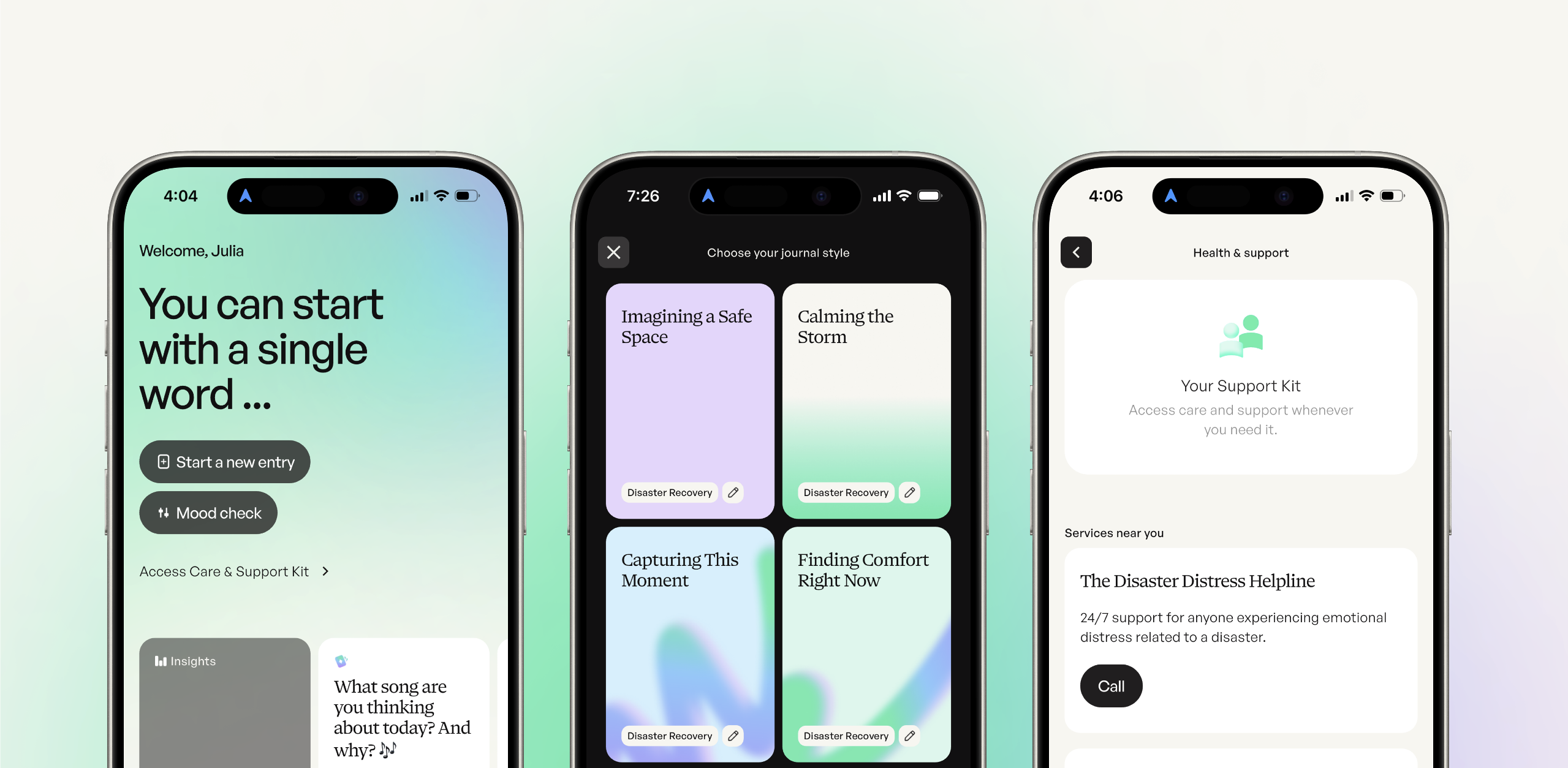Blog
Finding Calm After the Storm: A Journaling Guide for Teens and Families

Natural disasters like wildfires can be scary and disruptive. It’s normal to feel a mix of emotions afterward – sad, worried, confused, or even numb. Whether you are a teen sorting through your thoughts or an adult trying to get your family to reconnect, there are tools that can help. Journaling is one powerful tool to help you process these feelings, make sense of your experiences, and find a path toward healing. The journaling exercises below are designed to help teens and families start conversations, work through their emotions, and find ways to cope and rebuild together.
How to Use This Guide
- Go at Your Own Pace: Use this guide at a cadence that works for you — one activity a week, every day, or in the moment you need it.
- Opt for Privacy or Sharing: Keep your journal entries private or share them with others. It’s your choice.
- Make It a Team Effort: Take the opportunity to connect and reflect as a family. Use journaling as a chance to listen to and support each other without judgment.
- It’s Okay to Jump Around: Skip prompts that don’t feel right and return to them later if you’d like.
- Express Yourself Freely: Write, draw, or express yourself in whatever way feels comfortable.
- Explore Digital Journaling: These prompts can be used with any kind of journal. If you’re 13 or older and looking for a journaling app, check out MirrorJournal.com. It’s designed to help teens and adults explore their thoughts and feelings in a safe space. The prompts below are preloaded into the Mirror journaling app so they can be easily accessed anytime, anywhere.
When to Get Extra Help
Journaling can be a great way to process tough experiences, but sometimes extra help is needed. If you notice that you or a family member are struggling, it is important to seek an assessment by a doctor or mental health professional. Here are some signs to look out for:
- Nightmares or other trouble sleeping
- Being very scared or anxious most of the time
- Not wanting to do things previously enjoyed
- Having emotional outbursts
- Sadness and hopelessness
- Emotional numbness
- Having thoughts of self-harm or harm to others
Getting professional help is important when uncomfortable feelings happen more often, are intense, or are interfering with day-to-day activities, relationships, work, or school. In those situations, professionals can provide support and guidance.
Remember: It’s okay to ask for help.
Journaling Experiences
1. Checking in With Your Feelings
It’s normal to have lots of different feelings after a natural disaster. This activity helps you figure out what you’re feeling and how your body is reacting.
- Label Your Emotions: There is no wrong way to feel. Name three feelings you’ve had today. Then reflect: What made you feel that way?
- Let It Out: What’s happening right now that you need to let out? Write, draw, or voice-record your unfiltered thoughts about everything going on.
- Listen to Your Body: Where do emotions live in your body? Take a moment to map where you’re holding stress and what your body is telling you.
2. Imagining a Safe Space
This exercise helps create a feeling of safety and calm, even when things feel chaotic.
- Imagine a Safe Place: Close your eyes and picture an imaginary place where you feel safe and relaxed. What do you see, hear, and smell?
- Ask Yourself Who Brings You Comfort: Think about a person who makes you feel good. Why do they make you feel safe and comforted?
- Reinforce Positive Thinking: Come up with three positive sayings that make you feel strong and secure. Say, “I am safe,” “I am loved,” or “I can handle this.”
3. Calming the Storm
These tools can help you deal with strong feelings like worry, fear, and stress.
- Take Deep Breaths: Close your eyes and take five slow breaths in through your nose and out through your mouth. How does your body feel now?
- Use Your Senses: Look around and find one thing each that you can see, hear, smell, and touch. How do you feel?
- Create a Calm-Down Kit: Make a list of three activities that help you relax. Maybe it’s listening to music, drawing, playing a game, or talking to a friend.
4. Capturing This Moment
Recording what’s happening right now can help you process your experience.
- Create a Record: What do you see, hear, smell, and feel right now? Write notes, take photos, draw, or record a voice memo, whatever feels right.
- Notice the Little Details: In the chaos, what small moments stand out? Your pet’s reaction, someone’s words, or an unexpected feeling you’re noticing?
- Pay Attention to People: What do you notice about how people are acting right now — family, neighbors, first responders? How are they helping each other?
5. Finding Comfort Right Now
During stressful times, noticing what gives you comfort can help you feel more stable.
- Note the Positive: What’s helping you right now? Maybe calling a friend or playing a favorite playlist. What’s bringing you a bit of peace?
- Acknowledge Your Support: Who’s helping you stay grounded? Perhaps it’s a friend, a sibling, or someone who just gets it. What makes their support special?
- Identify Small Good Things: What little thing is helping you cope through the chaos? It could be a charged phone or an absorbing book.
6. Rebuilding Together
This activity is about looking ahead and figuring out how to rebuild, both your home and your emotional center.
- Ask Yourself What Rebuilding Looks Like: What does “rebuilding” mean to you? Getting back to a routine or feeling like yourself again? What small steps can you take?
- Gather Your Community: Who can help you rebuild? Family, friends, neighbors, teachers, or others? Remember, you don’t have to do this alone.
- Tally Your Super Strengths: What are you good at? Maybe kindness, humor, creativity, listening? How can your strengths help you and your family rebuild?
7. Checking in With Loved Ones
This helps families talk about their feelings and support each other.
- Get in Tune: What do you wish your family understood about you? Start with, “I wish you knew that…” Ask your loved ones to do the same.
- Share a Moment of Connection: When was a time this week when someone really listened to you? What did they do that made you feel heard?
- Deepen Your Understanding: What’s one thing you want your family to understand about what you’re going through? How might you explain or show it to them?
8. Hoping for the Future
It’s important to have hope, even when things are uncertain. This exercise helps you picture a brighter future.
- Imagine a Better Tomorrow: What positive change would you like to see in your life, family, or community in a year? Big or small, it counts.
- Ask Who Can Help: Think about someone who could help make that positive change happen. How might you ask for their help?
- Write a Note to Your Future Self: Craft an encouraging message to your future self. What would you tell yourself to stay strong and hopeful?
9. Observing a Glimmer in Nature
Even during challenging times, nature continues its peaceful rhythms, offering moments of calm. This prompt helps you find hope in renewal.
- Find Signs of Nature: What small signs of life do you notice today? Perhaps it’s a plant growing, a pet napping, or something else quietly unfolding.
- Cultivate Awe: What amazes you about nature? Flowers blooming, baby animals taking first steps, or coral reefs teeming with colorful fish?
- Capture Peace: What peaceful moment in nature would you like to remember? A cat in a sunbeam, new leaves on a plant, or rain on your window?
Resource List
- The Disaster Distress Helpline: 1-800-985-5990 (call or text) — 24/7 support for anyone experiencing emotional distress related to a disaster.
- Crisis Text Line: Text HOME to 741741 or.crisistextline.org — Free 24/7 support from trained crisis counselors.
- American Red Cross: www.redcross.org — Provides disaster relief and support services.
- FEMA Helpline: 1-800-621-3362 or DisasterAssistance.gov — Federal government disaster relief resources.
- The National Child Traumatic Stress Network (NCTSN): nctsn.org – Offers resources and information on helping children and teens cope with trauma.
- Local Mental Health Resources: Search online for “mental health services” or “therapists” in your county or city. Your school counselor or doctor can also be a good resource.
Sources
The following articles and exercises were sources of inspiration in developing these guides:
- Be Prepared (UCLA COE Tipsheet)
- Children & Recovery from Wildfires (CMOSC)
- Coping After a Natural Disaster (Zero to Three)
- Coping with Trauma and Stress in the Face of Wildfires (Zero to Three)
- Helping Children After a Wildfire: Tips for Caregivers and Teachers (NASP)
- How to Talk to Your Children About the California Wildfires (Parents Magazine)
- Wildfire Resources (NCTSN)
- Parent Guidelines for Helping Children Impacted by Wildfires (NCTSN)
